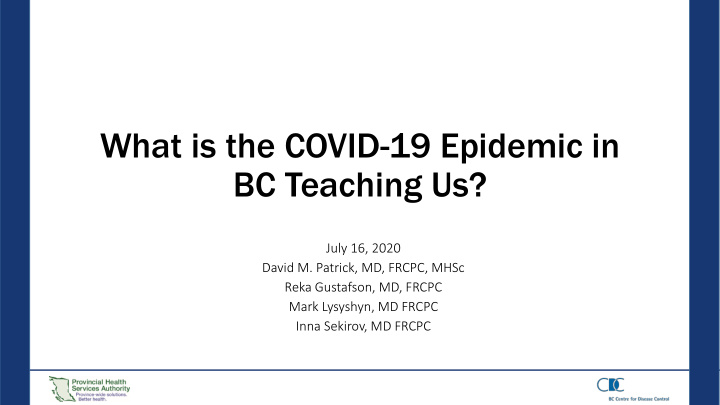



What is the COVID-19 Epidemic in BC Teaching Us? July 16, 2020 David M. Patrick, MD, FRCPC, MHSc Reka Gustafson, MD, FRCPC Mark Lysyshyn, MD FRCPC Inna Sekirov, MD FRCPC
Overall Epidemiological Picture • The number of reported cases remains low. • Most cases are related to local acquisition through a known case or cluster. • Long term care facility outbreaks account for the majority of COVID deaths. • BC continues to fare well, even when compared with countries who have had the most success in controlling the epidemic so far; importation from outside BC remains a risk • Symptom-based testing continues; turnaround times remain below 24 hours suggesting good testing capacity. • Models suggest that British Columbia remains close to threshold for epidemic control. 2
The number of reported cases remains low though daily rates over the last few days are higher than in late May. The majority of cases are related to local acquisition through a known case or cluster 3
The number of cases in hospital and critical care continues to remain low 4
Higher proportion of hospitalizations, ICU admissions and deaths are among men 25% 312 20% 15% 218 10% 115 108 81 69 5% 0% Hospitalizations ICU Deaths Female Male 5
Percentage of COVID-19 hospitalizations, ICU admissions and deaths by age in BC January 1 – July 15, 2020 (N=3,149) 50 127 45 40 89 53 35 79 103 Percentage 30 25 34 59 20 75 15 34 40 50 10 17 34 30 11 16 19 2 15 5 3 5 1 5 2 0 0 0 0 0 0 0 Hospitalizations ICU Deaths <10 10 to 19 20 to 29 30 to 39 40 to 49 50 to 59 60 to 69 70 to 79 80 to 89 90+ 6
5. Long term care facility outbreaks account for the majority of COVID-19 deaths in BC Proportion of COVID-19 Deaths by Setting in BC, 2020 (n=183) 7
BC continues to fare well compared with neighbouring jurisdictions but importation from outside BC remains a risk Surge follows Stage 4 re-opening (*) – gatherings of >50 people allowed indoors & outdoors, businesses reopened with unrestricted staffing at worksites * 8
1. Given the small numbers of reported cases at this time, case projections into the summer have large uncertainty Solid blue line: mean; shaded bands: 50% and 90% credible intervals; Open circles: reported cases Cases used for model fitting exclude those attributed to outbreak clusters 9
2. BC remains close to the threshold for epidemic control The number of reported cases in BC remains low and R t is less reliable at low case counts Solid black line: median R t ; grey band: 95% credible intervals; Purple bars: reported cases, excluding those attributed to outbreak clusters; The most recent case counts and R t values are not shown due to data lags from transmission to case reporting 10
What do we know now that we didn’t a few months ago • COVID-19 is a respiratory infection that is most commonly transmitted via close, prolonged contact with a person who is infectious with COVID-19 • 8/10 people get mild, self-limited illness • Those at higher risk of severe disease are older people (especially in the 7 th and 8 th decades of life) and those with underlying medical conditions • Children are less likely to be infected and less likely to transmit COVID-19 11
Known effective control measures • Wide-spread, low threshold testing • Early isolation of those infected with COVID-19 • Early identification and quarantine of high proportion of contacts • Protection of those most vulnerable • Frequent hand hygiene • Avoiding close prolonged contact with large numbers of people • In areas with high levels of community transmission there may be additional benefit from • Non-surgical masks in public • General “physical distancing measures” 12
PCR testing – Positivity rate remains low and TAT 24 hr Current ~1% Peak ~4.5% 13
Serological testing • Sensitivity is improved at >14 days post-symptoms onset • Main intended use for population-based studies • No evidence for routine clinical use • Any clinical diagnostic testing by consultation only • Currently little evidence on longevity of humoral response or protection from re-infection
Recommend
More recommend